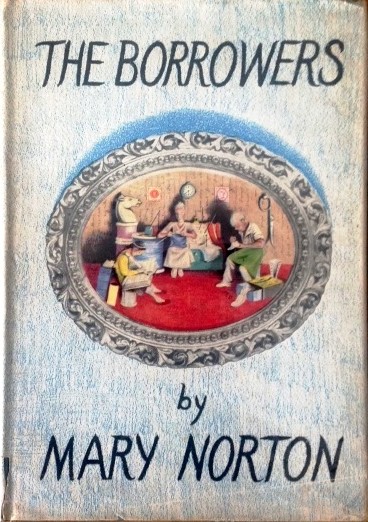Inspiring Young Readers
 posted on 08 Jun 2022
posted on 08 Jun 2022
The Borrowers by Mary Norton
I’m still trying hard to catch up with all the children’s classics I never got around to reading all those years ago and coming across a copy of Mary Norton’s 1952 fantasy, The Borrowers on the shelf was a good enough reason to settle down with it.
Even if, like me, you haven’t read the book there’s a good chance you’ll be aware of the story because of adaptations on film and television. It’s the tale of a miniature family that lives behind the wainscot of a big house and who live by ‘borrowing’ items they find around the house and spiriting them away.
The Borrowers themselves have a culture and history of their own but live in the constant fear of being discovered or ‘seen’ by the human giants who live in the rest of the house. Those who do get seen have to leave the house and go into ‘exile’ – living in the countryside where the comforts of home life are more rough and ready.
Norton went on to write five instalments of The Borrowers story and all of them feature the Clock family – so named because they live beneath the wall where the house clock is fitted. The family consists of wife, Homily, husband, Pod and their daughter Arrietty – who has now reached an age where she might be allowed to accompany her father on borrowing missions. She’s thrilled by this possibility but this moment actually becomes a turning point in the lives of the little people because Arietty isn’t just ‘seen’, she actually develops a relationship with one of the giants – known to the Borrowers as Boy. He turns out to be sympathetic to the little family and contrives to supply them with all sorts of gifts – including dolls house furniture – and the Borrowers experience an unprecedented time of bounty and fortune.
But, of course, as with all good children’s stories, there’s a fly in the ointment. In this case it’s the housekeeper, Mrs Driver who is no fan of children in general and Boy in particular. Thinking he’s up to no good and suspecting he’s harbouring a pet ferret, she is determined to (literally) smoke out the mystery. More by luck than judgement, Mrs Driver stumbles on the truth when she discovers the Borrower’s home and resolves to do away with them. Boy is locked away and the fumigators are sent for….
I’m not going to reveal how this all plays out because that would spoil the story if you haven’t already read it. However, what makes this story more interesting is that it’s actually being narrating in retrospect by Mrs May, Boy’s sister who, now an elderly woman, is telling the story to her young niece, Kate. Intriguingly, at the end, Norton leaves open the question of whether the Borrowers were real or just an invention of her brother.
Fast paced and engagingly written, it’s easy to see why Norton’s book became a classic and it’s important not to forget the contribution the book’s illustrator, Diana Stanley made to its success by giving shape and form to these little people living alongside the ‘human beans’.
Paperback copies of this first Borrower adventure are easy and cheap to find and, if you want a new copy, the book is still in print. Hardback first editions with jackets are, predictably enough, punishingly expensive for those wanting to add it to their collection of children’s literature.
Terry Potter
June 2022